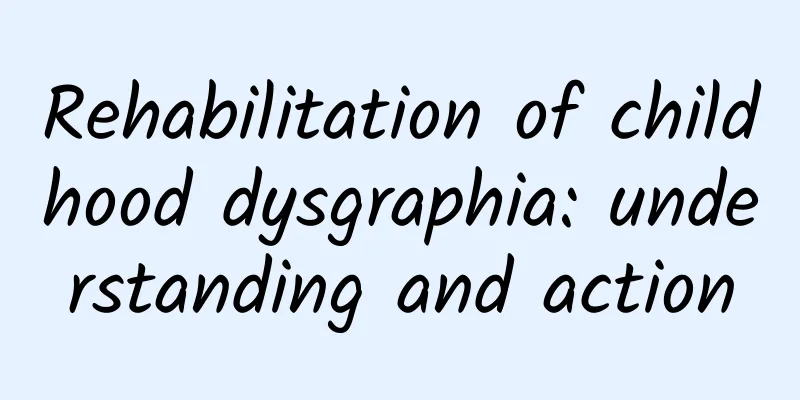Rehabilitation of childhood dysgraphia: understanding and action

|
Writing is a vital skill for children as they grow up. It is not only related to academic performance, but also an important way for children to express themselves and build self-confidence. However, some children encounter various difficulties in the writing process, which is what we call dysgraphia. This article aims to provide a detailed, easy-to-understand and practical reference for the rehabilitation treatment plan for children with dysgraphia for parents and educators without a medical background, so as to help children regain the joy and confidence of writing. 1. Understanding Dysgraphia Dysgraphia, also known as writing difficulties, is a common learning disability that affects approximately 5%-10% of school-age children worldwide. It is mainly manifested by decreased handwriting ability, unclear handwriting, frequent writing errors, or slow writing speed. It is worth noting that dysgraphia is not an intellectual problem, but is caused by differences in the way the brain processes language and motor skills. These children may have clear ideas when organizing their thoughts into writing, but they have difficulty putting them on paper. 2. Understanding the causes of dysgraphia The causes of writing difficulties are complex and varied, mainly including the following aspects: Neurodevelopmental factors: The neural circuits related to writing in the brain are not fully developed or damaged, resulting in poor coordination of writing movements. Visual perception problems: Insufficient visual-spatial perception ability makes it difficult to accurately judge the structure of characters and the writing position. Poor hand-eye coordination: Insufficient fine finger movements and wrist control affect writing stability and fluency. Concentration problems: Difficulty concentrating on writing tasks for long periods of time. Emotional and psychological factors: Negative emotions such as anxiety and inferiority affect writing motivation and performance. III. Principles of rehabilitation for dysgraphia The following principles should be followed in the rehabilitation of writing disorders: Personalized treatment: Each child's writing disorder is different, so the treatment plan should be tailored to the individual, taking into full consideration the child's age, interests, abilities and other factors. Comprehensive intervention: Combining multidisciplinary knowledge such as neurodevelopment, psychology, and education, using a variety of methods for comprehensive intervention. Step-by-step: Starting from basic skills, gradually increase the difficulty of writing to ensure that children can gain a sense of accomplishment at each stage. Home-school cooperation: Parents and schools should work closely together, pay attention to children's writing progress, and provide necessary support and help. 4. Rehabilitation methods for dysgraphia 1. Neurodevelopmental treatment a. Muscle strength and tension adjustment Isometric muscle contraction exercises: Guide children to perform isometric muscle contraction exercises on wrists and fingers to enhance muscle strength. Each exercise lasts for 5-10 seconds, repeated 10-15 times, and performed 2-3 sets per day. Dynamic muscle strengthening: Use light objects for grasping, lifting and rotating exercises, such as grasping a small ball and using plasticine, to increase the strength and endurance of the hand and forearm muscles. Muscle tone regulation: For children with high muscle tone, stretching exercises and deep tissue massage can be used to relax tense muscles; for children with low muscle tone, anti-gravity exercises (such as hanging games) and progressive resistance training can be used to increase muscle tone. b. Hand function training Fine motor exercises: Exercise finger flexibility and coordination through games such as stringing beads, jigsaw puzzles, and clamping objects. These activities help improve the separation of finger movements and precise control. Pre-writing skills exercises: including drawing straight lines, curves, circles and other graphics, as well as imitating simple strokes and letter shapes. These exercises help develop children's control over writing tools and their ability to perceive graphics. Writing simulation exercises: Use inkless or erasable pens to simulate writing on a sand tray, whiteboard, or special practice paper. This can help children practice writing movements and stroke order without the actual writing pressure. 2. Vision therapy a. Visual tracking training Use moving light spots, small balls or letter cards and ask your child to follow their tracks and make eye movements. This helps improve eye tracking ability and visual stability. Parents can set up simple visual tracking games at home, such as using a flashlight to project light spots on the wall and asking children to track the movement of the light spots. b. Visual discrimination training Present similar but slightly different graphics or letters and ask your child to identify and differentiate. This can improve your child's visual attention and ability to differentiate. Parents can prepare some visual discrimination cards and let their children practice every day. c. Visual memory training Show a group of graphics or letters and quickly cover them up, asking the child to recall and repeat. This helps strengthen the child's visual memory. Parents can use simple graphics cards or letter cards for this training. 3. Psychological therapy a. Cognitive behavioral therapy Help children identify and change negative thinking patterns and behavior habits. Enhance children's self-regulation and self-confidence by teaching relaxation techniques, time management strategies and ways to cope with stress. Parents can work with their children to develop learning plans, set small goals, and give positive feedback and encouragement when their children achieve their goals. b. Positive motivation Give timely positive feedback and rewards for children's efforts and progress. This can stimulate children's enthusiasm and motivation, and promote their more active participation in treatment and rehabilitation training. Parents can set up a reward mechanism, such as giving small gifts or praise after completing writing tasks. c. Emotional support Establish a trusting relationship with children and listen to their feelings and needs. Provide emotional support and comfort to help them relieve negative emotions such as anxiety and inferiority. Parents should communicate with their children frequently to understand their learning situation and psychological state and provide necessary emotional support. 5. Cooperation between Family and School a. Adjustment of family environment Create a quiet, clean, and well-lit writing environment for your child. Reduce distractions at home, such as television and game consoles, so that your child can focus on the writing task. Parents can set up a dedicated writing area and place necessary writing tools and materials. b. Supervision and guidance Parents should actively participate in their children's writing practice and provide necessary supervision and guidance. They should pay attention to their children's writing posture, stroke order, writing speed and other issues, and provide timely guidance and correction. Parents can work with their children to develop a practice plan to gradually increase the difficulty and speed of writing. c. Emotional communication Parents should frequently communicate with their children to understand their learning and mental state. They should encourage their children to express their thoughts and feelings and give them enough care and encouragement. Parents can regularly have heart-to-heart talks with their children to understand their learning and living conditions and help them solve problems they encounter. VI. Summary and Outlook Dysgraphia is a common learning disability among children, but it is not an unsolvable mystery. Through personalized treatment, comprehensive intervention and gradual rehabilitation training methods, most children can overcome dysgraphia and regain the joy and confidence of writing. Parents and educators should pay close attention to the progress of children's writing, provide necessary support and help, and contribute to the healthy growth and academic success of children. In future research and practice, we need to continue to explore more scientific and effective methods and technical means of dysgraphia rehabilitation to provide high-quality rehabilitation services for more children in need. At the same time, we also call on all sectors of society to pay attention to the issue of dysgraphia in children and jointly promote the development of children's mental health and educational rehabilitation. |
>>: Tea oil has nothing to do with tea leaves? But tea oil may be healthier
Recommend
5 most common breakfast combinations, not recommended for everyday use! (with recommendations from nutrition experts)
It's so hard to have a good breakfast! I was ...
Is sesame paste made with sesame oil or other oil? Which oils can be used to dilute sesame paste?
As we all know, sesame paste is a popular seasoni...
Is it normal to have one horizontal and one vertical in early pregnancy?
Is it normal to have one horizontal and one verti...
I got pregnant again four months after giving birth.
Couples generally do not use contraception after ...
What should you pay attention to after a miscarriage?
Miscarriage is a heavy topic. I believe every exp...
What kind of mentality should we have before the college entrance examination? Psychological counseling methods before the college entrance examination
After decades of diligent study, you are about to...
Can I detect pregnancy ten days after having sex during ovulation?
For couples who want a baby, if they have sex dur...
Ovarian cysts cause 5 major problems for women
Ovarian cyst is one of the four common gynecologi...
Do women still have sexual needs at the age of 40?
Women should know how to take good care of their ...
My period is scant and the discharge is black. Is there really such a thing as black period?
The normal menstruation lasts about seven days. F...
What causes back pain in pregnant women?
Low back pain in mid-pregnancy is generally a nor...
How to clear milk clots during lactation
Milk clots are common during lactation, but we al...
What kind of lychee is the one with a small core and lots of flesh? What are the varieties of lychees in Shenzhen?
There are many varieties of lychees, among which ...
Various gynecological diseases
In fact, every woman has gynecological diseases t...
Coffee causes cancer? Don’t panic! This article will help you sort out the love-hate relationship with coffee
Coffee originated in the Kaffa region of Ethiopia...









